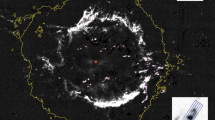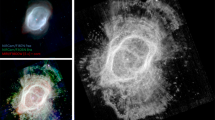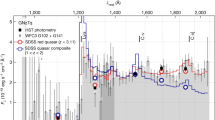Abstract
It has been argued1 that the extremely faint central stars of some planetary nebulae must be very hot, with most of their energy output in the ultraviolet. We now report the detection of the central star of the planetary nebula NGC2440 in a narrow-band continuum image using a CCD (charge-coupled device) camera at the prime focus of the Anglo-Australian telescope. Its visual magnitude has been measured as 18.9±0.2. Its Zanstra temperature2,3 is about 350,000 K, so that it is one of the hottest stars ever observed. Its radius corresponds to that of a nearly degenerate star. Theoretical calculations can explain the observed temperature and luminosity if it has a mass of at least 1.0 M⊙ and is in its cooling stage, but the predicted age of the nebula is considerably less than that required by the calculations. Furthermore, the present estimates of the progenitor mass of a 1-M⊙ white dwarf are brought into question.
This is a preview of subscription content, access via your institution
Access options
Subscribe to this journal
Receive 51 print issues and online access
$199.00 per year
only $3.90 per issue
Buy this article
- Purchase on Springer Link
- Instant access to full article PDF
Prices may be subject to local taxes which are calculated during checkout
Similar content being viewed by others
References
Pottasch, S. R. Astr. Astrophys. 94, L13–L16 (1981).
Zanstra, H. Publs Dom. astrophys. Obs. 4, 209–260 (1931).
Pottasch, S. R. Planetary Nebula (Reidel, Dordrecht, 1984).
Kaler, J. B. Astrophys. J. 210, 113–119 (1976).
Kohoutek, L. & Martin, W. Astr. Astrophys. 94, 365–372 (1981).
Atherton, P. D. et al. Astrophys. J. 232, 786–796 (1979).
Reay, N. K., Pottasch, S. R., Atherton, P. D. & Taylor, K. Astr. Astrophys. 137, 113–116 (1984).
Shaw, R. A. & Kaler, J. B. Astrophys. J. 295, 537–546 (1985).
Curtis, H. D. Univ. Calif. Publs Lick Obs. 13, 57–74 (1918).
Gathier, R. thesis, Univ. Groningen(1984).
Landolt, A. U. Astr. J. 88, 439–460 (1983).
Wamsteker, W. Astr. Astrophys. 97, 329–333 (1981).
Shields, G. A., Aller, L. H., Keyes, C. D. & Czyzak, S. J. Astrophys. J. 248, 569–583 (1981).
Stasinka, G. & Tylenda, R. Astr. Astrophys. (submitted).
Preite-Martinez, A. & Pottasch, S. R. Astr. Astrophys. 126, 31–44 (1983).
Paczynski, B. Acta astr. 21, 417–435 (1971).
Schonberner, D. Astr. Astrophys. 103, 118–130 (1981).
Weidmann, V. & Koester, D. Astr. Astrophys. 121, 77–84 (1983).
Author information
Authors and Affiliations
Rights and permissions
About this article
Cite this article
Atherton, P., Reay, N. & Pottasch, S. Detection of the very hot central star in NGC2440. Nature 320, 423–425 (1986). https://doi.org/10.1038/320423a0
Received:
Accepted:
Issue Date:
DOI: https://doi.org/10.1038/320423a0
This article is cited by
-
Ultraviolet detection of the nucleus of NGC2440
Nature (1987)
Comments
By submitting a comment you agree to abide by our Terms and Community Guidelines. If you find something abusive or that does not comply with our terms or guidelines please flag it as inappropriate.



